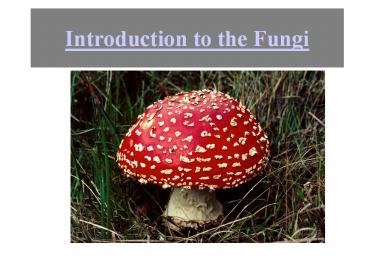Introduction to the Fungi PowerPoint PPT Presentation
1 / 17
Title: Introduction to the Fungi
1
Introduction to the Fungi
2
Basic phylogeny
3
- How many fungi do you see??
There is only one fungus. In this picture. Most
of it is underground. Each of the mushrooms you
see is a fruiting body (like a flower) that the
mushroom uses to reproduce.
4
Example of a humungous fungus
- Armillaria bulbosa a mushroom producing wood
decomposer - Covers at least 38 acres in a forest in Michigan
- Estimated to weigh 100 tons (size of a blue
whale) - Estimated to be at least 1500 yrs old
5
Kingdom Fungi
- Eukaryotic heterotrophs with external digestion
- Most are saprotrophs digest decaying material
- Important for recycling nutrients
- Range from a single cell (yeast) to mushrooms
whose mycelia cover hundreds of acres - Chitinous cell walls
- Are classified by the way the make spores (sac,
club, etc) - imperfect lack sexual reproduction
6
Structure of Fungi Most fungi are filamentous
because the main body is composed of thread-like
filaments called hyphae which form the mycelium.
Fungi which produce mushrooms are called club
fungi.
Hyphae the bricks from which the mushroom is
built
7
(No Transcript)
8
Fungi Importance
- Food production improved yield due to symbiosis
(plants and fungi mycorrhizae), leavened bread
(yeast) - Recycling nutrients (through decomposition)
- Industrial enzymes (bioremediation)
- Plant growth hormones
- Antibiotics (penicillin)
- Lichens symbiosis between fungi and algae
- Good indicators of air quality
9
Penicillium produced by a fungus
WWI, bacterial infections killed more soldiers
than bullets. 1928 Dr. Andrew Fleming working at
St. Marys Hospital in London noticed that mold
growing on staph bacterial culture plates had
killed the pathogen
zone of dead bacteria
10
Penicillin kills bacteria by interfering with the
ability to synthesize cell wall.
11
Mycorrhizae fungi/plant symbiosis
- myco fungus and rhiza root
- Symbiotic association between plant roots and
fungi - Advantages to plant
- Fungi are better than plants at acquiring mineral
nutrition (P,K, N) from the soil. - Fungi improve a plants access to water because
fungi - can access greater soil volume
- can break molecules down into useable forms
- Haustoria
- specialized hyphae
- for absorption
12
Mycorrhizae Fungi can access more of the soil
because hyphae of the fungus are smaller than
plant roots
Root Hair
Hyphae are 1/500th the diameter of a plant root
hair
hyphae
13
Fungi expand the surface area available for
nutrient uptake
14
Lichens fungi/algae symbiosis
Fungus mycobiont Algae photobiont Controlled
parasitism?? Lichen are among the pioneer
species which create soil in areas that have
only rocks (such as a lava field). Can withstand
areas of drought and extreme temperature slow
growth. They absorb nutrients from the air and
from rainfall so lichen are good indicators of
air quality.
15
Absorptive nutrition makes lichens good
indicators of air quality
16
Some fungi are predators.
- They catch and digest other organisms (like
nematodes)
But still absorptive nutrition! Just have to
catch it first
17
Negative impacts of fungi
- In animals, infections such as athletes foot,
ringworm. - In plants, masses of spores cause discolouration
of the leaves so infections often called smuts,
rusts, spots and other names describing the
symptoms. Beetles were vector for Dutch Elm
disease.
Eyespot of wheat
Tarspot of sycamore
Leaf rust of daisy

